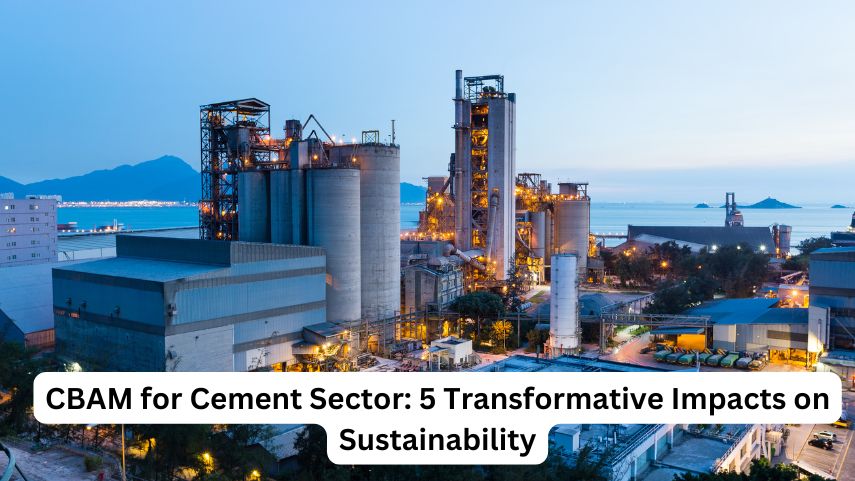The Carbon Border Adjustment Mechanism (CBAM) is set to redefine sustainability standards and economic dynamics in the cement sector. This initiative, part of the European Union’s ambitious Green Deal, aims to motivate producers and importers to reduce carbon emissions by aligning costs with environmental impacts. In this article, we will explore how CBAM for cement sector serves as a crucial pivot toward greener practices, ensuring that environmental responsibility becomes a cornerstone of industrial competitiveness.
What is CBAM? Understanding CBAM for Cement Sector
CBAM stands for Carbon Border Adjustment Mechanism, a policy tool designed to adjust the prices of goods imported into the EU based on their carbon content. For the cement sector, this means that imports will be assessed for their environmental impact, primarily focusing on carbon emissions associated with their production. The intent is to prevent “carbon leakage,” where companies might relocate production to countries with laxer emission standards, and to level the playing field for domestic producers committed to reducing their carbon footprint.
Impact of CBAM on the Cement Sector
1. Increased Cost Transparency
The introduction of CBAM in the cement sector promises to enhance cost transparency significantly. By factoring environmental costs into the price of cement, both producers and consumers will become more aware of the true cost of carbon emissions. This visibility is expected to drive more informed purchasing decisions and encourage investments in cleaner technologies.
2. Stimulation of Eco-friendly Innovations
One of the most significant impacts of CBAM is its potential to stimulate innovation within the cement industry. Manufacturers are likely to accelerate the development and adoption of new technologies that reduce carbon emissions. This could include advancements in energy efficiency, the use of alternative, less carbon-intensive materials, and the capture and storage of carbon emissions.
3. Market Shifts and New Opportunities
CBAM is poised to reshape market dynamics by making greener cement products more competitive. Cement producers who have invested in reducing their carbon emissions may find new market opportunities as environmentally conscious buyers prefer their products. Additionally, this shift is likely to spur the growth of niche markets for innovative cement alternatives that offer lower carbon footprints.
4. Regulatory Alignment and Compliance Challenges
With CBAM, cement manufacturers will face new regulatory frameworks that require meticulous compliance. This adjustment will necessitate significant administrative effort and potentially complex legal challenges. However, it also presents an opportunity for the cement sector to align more closely with global environmental standards, promoting a more sustainable approach to industrial production.
5. Enhanced Global Competitiveness
At last, the execution of CBAM for the cement division seem upgrade the worldwide competitiveness of EU producers. By incentivizing cleaner production methods, European cement producers may set new international benchmarks for environmental performance in the industry, potentially leading to a global shift towards more sustainable practices in cement production.
Challenges and Considerations
While the benefits of CBAM are clear, its implementation is not without challenges. The cement sector must prepare for initial financial impacts, as the cost of adjustments may be significant. There is also the potential for trade disputes as external producers adjust to the new pricing regime, which could affect market stability temporarily.
Conclusion: A Step Towards a Greener Future
The introduction of CBAM in the cement sector marks a pivotal step towards integrating environmental accountability into the core of industrial activities. As we move forward, it will be crucial for stakeholders across the sector to collaborate in refining and implementing this mechanism. By doing so, the cement industry can significantly contribute to a more sustainable and environmentally responsible global economy.
The cement industry is one of the major segments of the CBAM directions, and its rules apply in an unexpected way to it. The CBAM system, presented to avoid carbon spillage and control carbon emanations in Europe, incorporates sector-specific directions. The list of rules and compliances too changes amid the move period and authoritative stage. Europe’s cement industry valuation is anticipated to increment from US$19,026.5 million in 2023 to US$31,742.5 million in 2033. Concurring to a report by UK-based PRNewswire, Europe’s request for cement is expected to develop at 5.3 per cent from 2023 to 2033. Given the quickly developing cement industry showcase, exporters exterior the EU must be prepared to remain ahead by assembly CBAM compliances.






